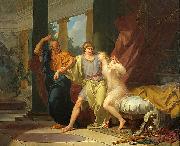
Oil On
Canvas, Real Flavor of Old Masters
|
Baron Jean-Baptiste Regnault
|
|||
|
|
|||
| Paris 1754-1829 French painter. His first teacher was the history painter Jean Bardin, who took him to Rome in 1768. Back in Paris in 1772, he transferred to the studio of Nicolas-Bernard Lepicie. In 1776 he won the Prix de Rome with Alexander and Diogenes (Paris, Ecole N. Sup. B.-A.) and returned to Rome, where he was to spend the next four years at the Academie de France in the company of Jacques-Louis David and Jean-Francois-Pierre Peyron. While witnessing at first hand Peyron's development of a manner indebted to Poussin and David's conversion to Caravaggesque realism, Regnault inclined first towards a Late Baroque mode in a Baptism of Christ (untraced; recorded in two sketches and an etching), then, in Perseus Washing his Hands (1779; Louisville, KY, Speed A. Mus.), to the static Neo-classicism of Anton Raphael Mengs. | |||
|
|
|||
|
|
Socrates Tears Alcibiades from the Embrace of Sensual Pleasure new25/Baron Jean-Baptiste Regnault-954576.jpg Painting ID:: 85350 Visit European Gallery |
Oil on canvas, 1791. Date Dimensions H. 46 cm (18 in.), W. 68 cm (26 ¾ in.) cyf | |
Height Width |
INS/CM |
||
|
X |
|
||
|
|
|||







